

| sample frequency | = | 8 kHz |
| frame duration | = | 10 msec |
| window duration | = | 25 msec (200 points) |
| FFT length | = | 256 points |
| max frequency | = | sample frequency / 2 = 4 kHz |
| max mel frequency | = | max frequency in mel = 2146.1 mel |
| number of mel frequency scale bins | = | 24 bins |
| mel frequency resolution | = | max mel frequency / (24 + 1) = 85.84 mel |
| center frequency | = | i * 85.84 mel |
| Bin # | Continuous Frequency | Discrete Frequency | ||
| Start (Hz/Mel) |
Center (Hz/Mel) |
Stop (Hz/Mel) |
Range (Index) |
|
| 1 | 0.0 0.0 |
55.4 85.8 |
115.2 171.7 |
0 - 3 |
| 2 | 55.4 85.8 |
115.2 171.7 |
179.7 257.5 |
2 - 5 |
| 3 | 115.2 171.7 |
179.7 257.5 |
249.3 343.4 |
4 - 7 |
| 4 | 179.7 257.5 |
249.3 343.4 |
324.5 429.2 |
6 - 10 |
| 5 | 249.3 343.4 |
324.5 429.2 |
405.5 515.1 |
8 - 12 |
| 6 | 324.5 429.2 |
405.5 515.1 |
493.0 600.9 |
11 - 15 |
| 7 | 405.5 515.1 |
493.0 600.9 |
587.5 686.7 |
13 - 18 |
| 8 | 493.0 600.9 |
587.5 686.7 |
689.4 772.6 |
16 - 22 |
| 9 | 587.5 686.7 |
689.4 772.6 |
799.3 858.4 |
19 - 25 |
| 10 | 689.4 772.6 |
799.3 858.4 |
918.0 944.3 |
23 - 29 |
| 11 | 799.3 858.4 |
918.0 944.3 |
1046.1 1030.1 |
26 - 33 |
| 12 | 918.0 944.3 |
1046.1 1030.1 |
1184.2 1116.0 |
30 - 37 |
| 13 | 1046.1 1030.1 |
1184.2 1116.0 |
1333.4 1201.8 |
34 - 42 |
| 14 | 1184.2 1116.0 |
1333.4 1201.8 |
1494.3 1287.6 |
38 - 47 |
| 15 | 1333.4 1201.8 |
1494.3 1287.6 |
1668.0 1373.5 |
43 - 53 |
| 16 | 1494.3 1287.6 |
1668.0 1373.5 |
1855.4 1459.3 |
48 - 59 |
| 17 | 1668.0 1373.5 |
1855.4 1459.3 |
2057.6 1545.2 |
54 - 65 |
| 18 | 1855.4 1459.3 |
2057.6 1545.2 |
2275.9 1631.0 |
60 - 72 |
| 19 | 2057.6 1545.2 |
2275.9 1631.0 |
2511.4 1716.9 |
66 - 80 |
| 20 | 2275.9 1631.0 |
2511.4 1716.9 |
2765.6 1802.7 |
73 - 88 |
| 21 | 2511.4 1716.9 |
2765.6 1802.7 |
3039.9 1888.5 |
81 - 97 |
| 22 | 2765.6 1802.7 |
3039.9 1888.5 |
3335.9 1974.4 |
89 - 106 |
| 23 | 3039.9 1888.5 |
3335.9 1974.4 |
3655.3 2060.2 |
98 - 116 |
| 24 | 3335.9 1974.4 |
3655.3 2060.2 |
4000.0 2146.1 |
107 - 127 |